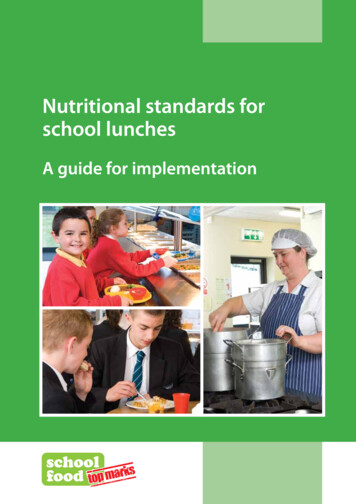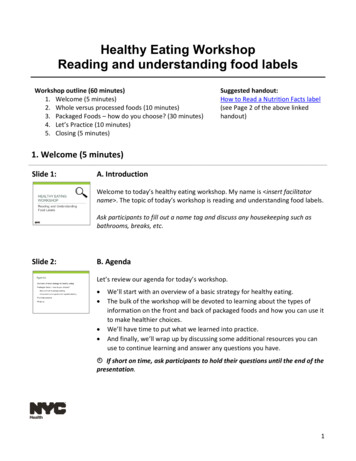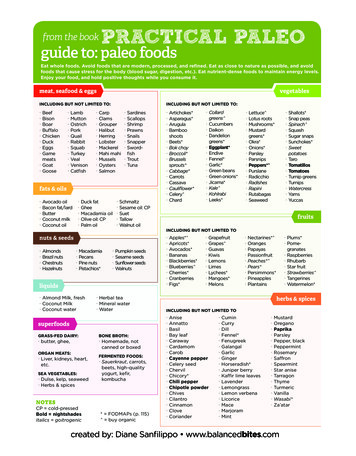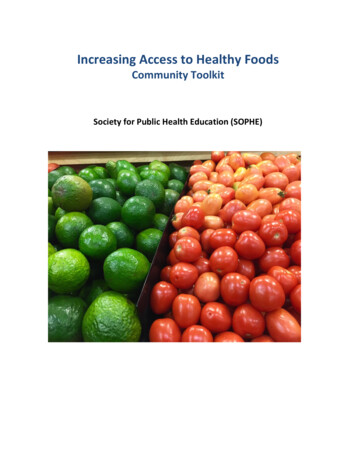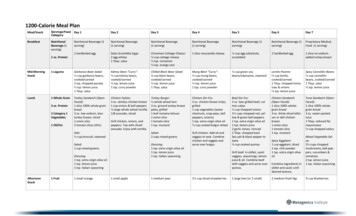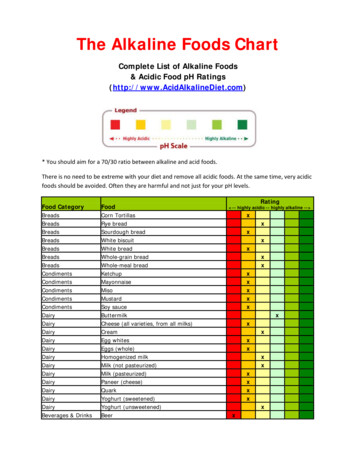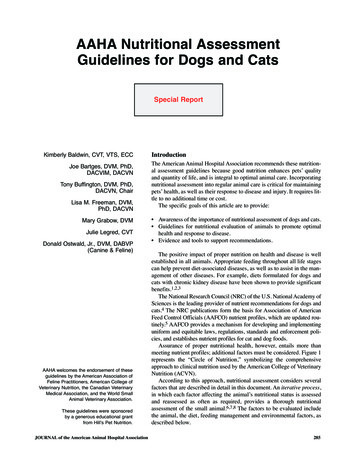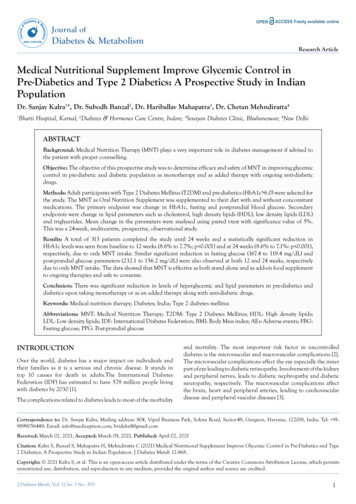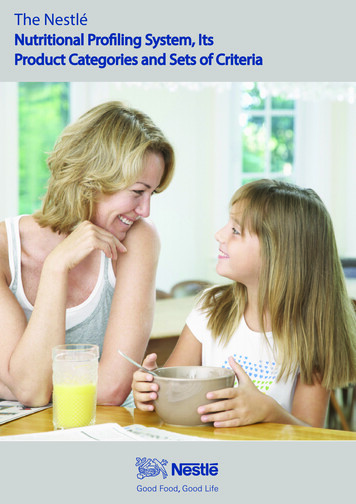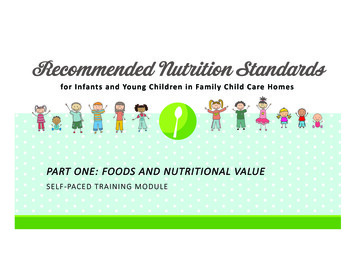
Transcription
for Infants and Young Children in Family Child Care HomesPART ONE: FOODS AND NUTRITIONAL VALUESELF-PACED TRAINING MODULE
What are the Nutrition Standards?Ø Guidelines for nutrition in family child care homesØ Developed by a panel of child care and nutrition expertsØ Two categories of standards Recommended foods Recommended practices for preparing and serving foodØ Divided into 2 tiers Tier 1 (required implementation) Tier 2 (optional implementaton)Tier 1Tier 2
Content OverviewPART ONE: SELF-PACED Breastfeeding Milk and Other Beverages Grains and Proteins Vegetables and Fruits Sugar and SodiumPART TWO: LIVE Review of Part One Introduction of Solid Foods Healthy Feeding Practices
DefinitionsThese terms will be used to refer to different age groups:Ø Infants are from birth to 12 months of ageØ Young children are over 12 months of age
BreastfeedingBreastmilk is healthiest source of nutrition for infantsØ Contains all nutrients infants needØ Protects infants from common illnesses, allergies,and obesityØ Promotes good health for mothers
Supporting BreastfeedingØ Provide information about how you supportbreastfeeding in your family child care homeØ Provide a quiet, comfortable, and privateplace for mothers to breastfeedØ Provide caregivers a place torefrigerate/store expressed breast milk
Other Beverages for InfantsØ Iron-fortified formula is only substitute for breast milkØ Do not provide other milk, unless instructed by doctorØ At 6-9 months of age, encourage infants to drink waterfrom a cup with assistanceØ Do not provide any juice or sweetened drinks
Breastfeeding and Other Beverages for InfantsTier 1Ø Support and encourage breastfeedingØ Provide adequate refrigerator/storage space forbreastmilkØ Offer only breast milk and/or iron-fortified infantformula for infants 0-12 monthsØ No other milk for infants, unless a doctor’s noteØ Do not serve 100% juice, juice drinks or other beverages
Breastfeeding and Other Beverages for InfantsTier 2Ø While breast milk and formulaare the best sources of water,at 6-9 months begin providing acup for additional drinking water
Milk and Other BeveragesØ Cow’s milk provides a good source of calcium, vitamin Dand protein for children over 12 monthsØ Infants under 12 months cannot digest cow’s milk properlyØ Children who do not drink cow’s milk can drink anutritionally equivalent milk (such as soy milk) if requestedby their parent or medical providerØ Flavored milks contain added sugars that can lead tocavities and overweight
Milk and Other BeveragesØCow’s milk naturally contains fatØWhole milk contains full fat and isappropriate for the nutritional needs ofchildren between 12-24 months oldØChildren older than 24 months donot need as much fat in their dietand should switch to lowfat orfat-free options
Milk and Other BeveragesØ Water served in a cup is the best choice foryoung children who are thirstyØ Important for hydrationØ Reduces acid in the mouth that cancause cavitiesØ Contains no caloriesØ Infants under 6 months get enoughhydration from breastmilk or formula anddo not need additional water
Milk and Other BeveragesØ Whole fruit is more nutritious than fruit juice because itcontains fewer calories and provides fiberØ Juice that is not 100% fruit juice has added sugar thatcan lead to oral cavities and overweightØ Young children who drink 100% fruit juice should drinkless than 4 to 6 ounces in 24 hoursØ Drinking greater amounts of 100% fruit juice has beenassociated with health problems
Milk and Other BeveragesTier 1Ø Do not serve sugar sweetenedbeveragesØ Rarely or never offer 100%fruit juiceØ If offered, give no more than 4to 6 ounces of 100% fruit juiceper 24 hours
Milk and Other BeveragesTier 1Ø Ensure that water is easilyavailable for self-serve,indoors and outdoors, andactively offered with mealsand snacks and at other timesas appropriate
Milk and Other BeveragesTier 2Ø Toddlers 1 to 2 years should drink oneserving of unflavored whole milk at least2 times per dayØ Children over 2 years should drink oneserving of unflavored reduced fat (1%) orfat-free milk at least 2 times per day
Milk and Other BeveragesTier 2Ø Offer only non-dairy milk substitutions(such as soy milk) that are nutritionallyequivalent to milk
GrainsØ Whole grains provideimportant nutrientsØ Eating whole grains helpschildren grow at a healthyweight, and reducesconstipation
Grains for Infants 6 – 12 MonthsGrains include iron-fortified infant cereals*:Ø Rice cerealØ Oat, barley or wheat cerealØ Mixed grain cereal*The live training will contain in-depth informationabout the introduction of solid foods for infants.
GrainsSERVE: Whole Grain FoodsAVOID: Non-Whole Grain Foods Brown bread, labeled wholegrain or multi-grain Brown rice Whole wheat tortillas Barley or farro Quinoa Whole wheat pasta Oatmeal White or enriched bread White rice Flour tortillas Pasta or noodles madefrom white flour Desserts such as cake,cookies, pie, pastries ordonuts
GrainsTier 1Tier 2Ø Offer iron-fortified infantcereals for infants 6 upto 12 months oldØ Do not serve white (nonwhole) grains or whitegrain-based desserts
ProteinsØ Protein helps build bones, muscles, cartilage, skin, andblood, and make hormones and vitaminsØ Protein-rich foods include fish, lean meats, poultry, eggs,beans, peas, soy products, cheese and yogurtØ Products made from soy and other sources of vegetableproteins add variety
ProteinsØ Infants over 6 months should eat proteinsprepared according to their developmentalability to eat different texturesØ Pureed, mashed or groundØ Young children should be offered leanproteins at least 2 times per day
ProteinsØ Natural cheese and yogurt are agood source of calcium, Vitamin Dand proteinØ Cheese spreads or imitationcheeses are not a healthysubstitute for natural cheese
ProteinsØ Cheese and yogurt also contain fatØ Lowfat or reduced fat have fewer caloriesØ Flavored yogurts may contain added sugarØ Add fresh fruit to plain yogurt instead of servingflavored yogurt
ProteinsØ Processed meats such as hot dogs,sausage, and bacon are high in fat,salt, and chemicals called nitratesØ Deep fried or pre-fried foods such asfish sticks and chicken nuggets arealso high in fat and salt
ProteinsTier 1ØOffer proteins such as soft cooked egg,beans, meat, poultry, and fish without bonesto infants 6 to 12 months oldØOffer young children lean protein at least 2times a day, such as seafood, fish, lean meat,poultry, eggs, beans, peas, soy products, tofu,and unsalted nuts and seedsØDo not serve processed meats or deep friedor pre-fried meats, poultry or fish
ProteinsØ Serve protein with no added saltTier 2Ø Offer natural cheese no more than 1-2 timesper dayØ Do not serve cheese food/spreadØ Choose low-fat or reduced-fat cheeseØ Offer yogurt that contains less than 23 gramsof sugar per 6 oz no more than 1 time per day
VegetablesØ Vegetables are a healthy choice forinfants older than 6 months andyoung childrenØ Vegetables provide vitamins andminerals that support youngchildren’s rapid growth anddevelopmentØ Diets rich in vegetables reduce therisk of health problems
VegetablesØ Infants over 6 months should eat cookedvegetables prepared according to theirdevelopmental ability to eat different texturesØ Pureed, mashed or soft wholeØ Different vegetable textures help develop theinfant’s sensory skillsØ Include a “rainbow” of vegetables of differentcolors for a variety of nutrients
VegetablesØ Frozen or canned vegetables shouldhave no added ingredients such assalt, fat, or sugarØ Deep fried and pre-fried bakedvegetables are high in fat and salt
VegetablesTier 1Ø Offer pureed, mashed or whole vegetables forinfants 6 to 12 monthsØ Offer young children vegetables at least 2times per dayØ Vegetables can be fresh, frozen or canned(with no added salt, fat, or sugar)Ø Do not serve deep fried or pre-fried bakedvegetables
VegetablesTier 2Ø Offer dark green, orange, red, or deepyellow vegetables at least 1 time per day.
FruitsØ Fruits are a healthy food choicefor infants older than 6 monthsand young childrenØ Fruits provide vitamins andminerals for growth anddevelopmentØ Include fruits from a variety ofcolors
FruitsØ Infants over 6 months should eatfruits prepared according to theirdevelopmental ability to eat differenttexturesØ Pureed, mashed or soft wholeØ Young children should be offeredfruit at least 2 times per day
FruitsØ Frozen or canned fruits shouldhave no added ingredients suchsugar or sweetenersØ Fruit is naturally sweet – do notadd sugar, honey, or othersweeteners
FruitsTier 1Ø Offer infants older than 6 months unsweetenedwhole, mashed, or pureed fruitsØ Offer young children fruit at least 2 times per dayØ Fruit can be fresh, frozen, or canned (with noadded sugars)
Sugar and SodiumØ Foods high in added sugars or sugarequivalents should be avoidedØ Too much sugar can contribute tochildhood health problems such asoverweight, oral cavities and diabetes
Sugar and SodiumCheck the ingredients of commercial foods to see if sugar orthese sugar equivalents have been added:Ø High fructose corn syrupØ Cane sugarØ FructoseØ Evaporated cane juiceØ Corn syrupØ SucroseØ HoneyØ Sucralose
Sugar and SodiumØ The amount of salt in food isusually listed on a nutritionlabel as “sodium”Ø The body only needs a smallamount of sodiumØ Too much sodium can increaseblood pressureØ Processed foods may have alot of sodium
Sugar and SodiumTier 1Ø Do not serve foods with added sugar or sugarequivalents listed as the first or secondingredientsØ Do not offer foods having a combination of 3or more kinds of sugar or sugar equivalents
Sugar and SodiumTier 2Ø Do not serve low calorie sweeteners or itemscontaining low-calorie sweeteners like dietfoods or diet beveragesØ Do not serve high salt foodsØ more than 200 mg sodium per snack itemor 480 mg per entréeØ Do not add salt to food
you have completed the module!Please note any questions you have and bring them with you to thelive training for discussion.
AcknowledgementsNUTRITION STANDARDS PILOT TEAMNutrition Policy Institute: Gemma DiMatteo Klara Gurzo Kenneth Hecht Lorrene RitchieCalifornia Food Policy Advocates: Melissa Cannon Elyse Homel VitaleUCSF California Childcare Health Program: Abbey Alkon Victoria Keeton Bobbie Rose
A Special Thank You to our FundersAcross counties: The David and Lucile Packard FoundationSanta Clara County: FIRST 5 Santa Clara CountySan Diego County: Moxie Foundation, Price Philanthropies,& The California EndowmentSan Joaquin County: Sunlight Giving Foundation
Breastmilk is healthiest source of nutrition for infants . ØDo not serve 100% juice, juice drinks or other beverages Breastfeeding and Other Beverages for Infants . ØProtein-rich foods includefish, lean meats, poultry, eggs, beans, peas, soy products, cheese and yogurt
